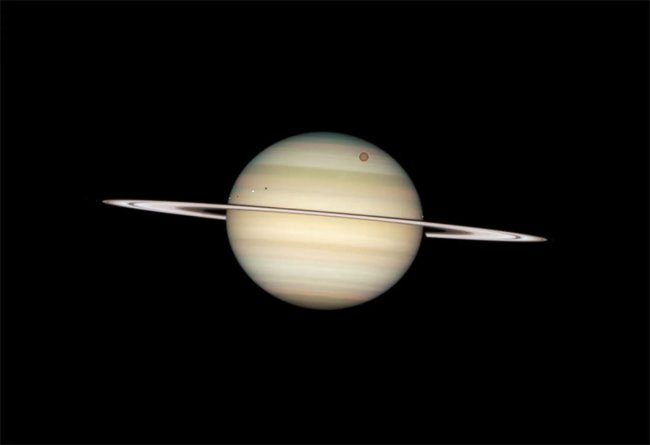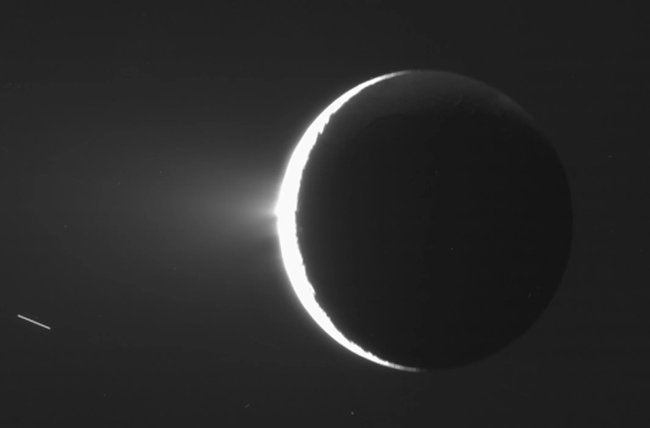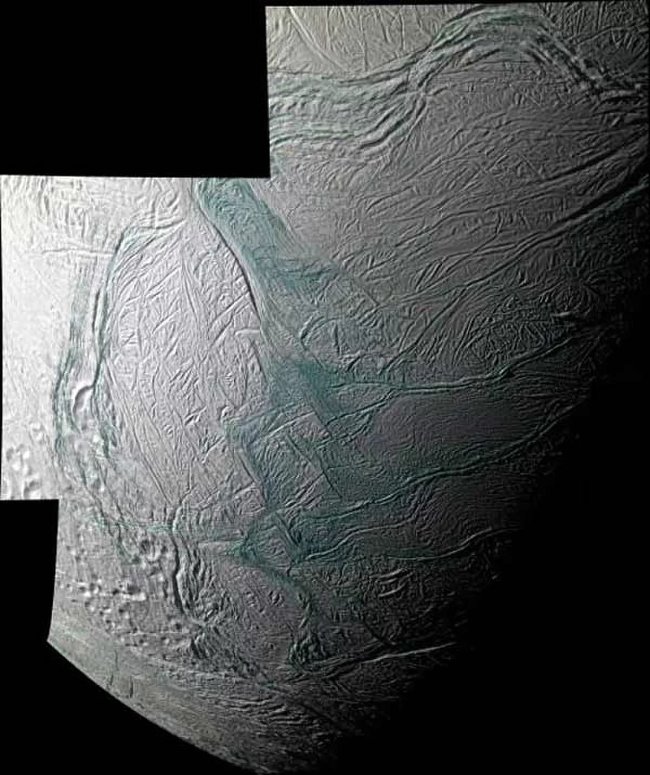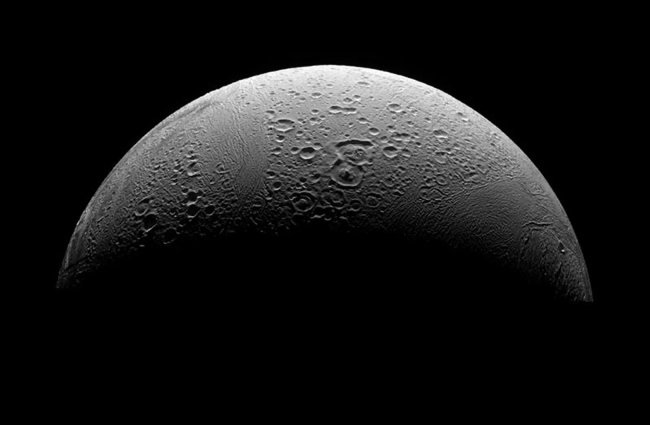50 images of Saturn's Enceladus moon - where life may exist (Part 2)
If it is determined that Saturn's moon Enceladus exists, this will be one of the greatest discoveries in human history. Let us continue to admire 50 images of Saturn's Enceladus moon - where life can exist (Part 2) below!
Saturn with its four moons

Photo source: NASA, ESA, and the Hubble Heritage Team (STScI / AURA)
According to the observed image, Titan orange giant moon has a shadow on the northern end of Saturn. Below is the moon Titan , near the perimeter of the belt and to the left is the Moon Mimas , a much smaller shade located on Saturn's equator. The left side of Saturn's belt is the Dione moon and blurry rather than the moon Enceladus .
Enceladus satellite on April 24, 2007
 Photo source: NASA / JPL / Space Science Institute
Photo source: NASA / JPL / Space Science Institute
The prototype image of Enceladus satellite was taken on April 24, 2007.
Mosaic picture of moon Enceladus in Saturn
 Photo source: NASA / JPL / Space Science Institute
Photo source: NASA / JPL / Space Science Institute
Enceladus Saturn's giant crystal carpet shows the vast regional context that NASA's Cassini spacecraft had obtained a few minutes earlier during the exploration on August 11, 2008.
The northernmost region of Enceladus satellite
 Photo source: NASA / JPL / Space Science Institute
Photo source: NASA / JPL / Space Science Institute
This image is the highest resolution view obtained from the northernmost region of Enceladus satellite. The image is directed south through concave holes in the northernmost region of Enceladus satellite. NASA's Cassini spacecraft discovered this during a probe on March 12, 2008.
Steam stream on Saturn moon
 Photo source: NASA / JPL / Space Science Institute
Photo source: NASA / JPL / Space Science Institute
The untreated prototype of Enceladus satellite was taken by NASA's Cassini probe on November 2, 2009. Light rays of steam can be seen on the South Pole of the moon Enceladus.
Water tape on Saturn's Enceladus satellite
 Photo source: NASA / JPL / Space Science Institute
Photo source: NASA / JPL / Space Science Institute
There are at least four different water bands emanating from the southernmost region of the moon Enceladus Saturn. The image was taken with visible light with the narrow angle of the Cassini spacecraft on December 25, 2009.
The Casini spacecraft explores the moons inside Saturn
 Photo source: NASA / JPL / Space Science Institute
Photo source: NASA / JPL / Space Science Institute
NASA's Casini spacecraft captured the prototype image of Enceladus satellite on April 26, 2010. The camera placed about 946,585 kilometers away toward Enceladus satellite and the image was taken with CL1 filters. and IR3. This image has not been validated or calibrated. Validated / calibrated images will be stored at NASA's Planetary Data Storage System in 2011.
The Cassini spacecraft found water signs in Saturn's moon form
 Photo source: NASA / JPL / Space Science Institute
Photo source: NASA / JPL / Space Science Institute
New images of Saturn's moon Enceladus illuminated by the Sun show the fountain-like sources of matter passing through the southernmost region. Images are clearly shown in colors.
Water spray from Saturn's cracks in the moon
 Photo source: Cassini Imaging Team and NASA / JPL / SSI
Photo source: Cassini Imaging Team and NASA / JPL / SSI
The image of the Cassini spacecraft illustrates the light emitted from the nozzles in the southernmost region of Enceladus satellite.
The Cassini spacecraft was captured at Saturn's icy moon
 Photo source: Karl Kofoed
Photo source: Karl Kofoed
According to this photo, the Cassini spacecraft flew over Enceladus satellite in the nearest position to observe / study the flow of water from the geyser erupting at the southern pole of the moon.
NASA "restored" the Cassini spacecraft during the flight on Saturn
 Photo source: NASA / JPL
Photo source: NASA / JPL
This photo shows the plan to fly directly to Saturn's Enceladus satellite by NASA's Cassini spacecraft on November 30, 2010. Cassini's warship " woke up " from a safe mode " hibernation. " "on November 24.
Ultraviolet light near Saturn's northernmost region
 Photo source: Ken Moscati and Abi Rymer, JHUAPL Including data from NASA / JPL / JHUAPL / University of Colorado / Central Arizona College / SSI
Photo source: Ken Moscati and Abi Rymer, JHUAPL Including data from NASA / JPL / JHUAPL / University of Colorado / Central Arizona College / SSI
This image shows a bright spot of ultraviolet light near Saturn's northernmost region that appears to be a " sign " of magnetic connection between Saturn and Enceladus. The magnetic fields and footprints cannot be observed with the naked eye but have been detected by ultraviolet spectroscopy, magnetic fields and point instruments on NASA's Cassini spacecraft.
Saturn's thin belt with the moon
 Photo source: Cassini Imaging Team, ISS, JPL, ESA, NASA
Photo source: Cassini Imaging Team, ISS, JPL, ESA, NASA
This image was taken by the Cassini spacecraft to highlight the thinness of Saturn's belt, only about 1 km thick. Saturn's Titan moon passes through the belt, while the smaller moon Enceladus appears very small on the right.
Cassini spacecraft explores Saturn's icy moon
 Photo source: NASA / JPL.
Photo source: NASA / JPL.
Saturn's Enceladus satellite image was captured by the Cassini spacecraft.
Three moons of Saturn
 Photo source: NASA / JPL / Space Science Institute
Photo source: NASA / JPL / Space Science Institute
The three Saturn's moons appear in the same picture to the far north of the belt.The moon Rhea ( 949 miles or 1,528 km ) is closest to the Cassini spacecraft, most clearly visible compared to the other two moons and is in the center of the image. Moon Enceladus ( 313 miles or 504 km ) on the right side of the moon Rhea. The Dione Moon (698 miles or 1,123 km ) is on the left side of the moon Rhea, partially obscured by Saturn. Saturn is on the left side of this image but due to shooting at night it is too dark to see.
Image of Saturn belt with 5 moons
 Photo source: NASA / JPL-Caltech / Space Science Institute
Photo source: NASA / JPL-Caltech / Space Science Institute
This image was taken by NASA's Cassini spacecraft on July 29, 2011, showing Saturn's A and F belts. From the left is the moon Janus, Pandora, Enceladus, Mimas and Rhea.
Snow on Saturn's moon Enceladus
 Photo source: Paul Schenk (Lunar and Planetary Institute, Houston)
Photo source: Paul Schenk (Lunar and Planetary Institute, Houston)
Image of the surface of Enceladus satellite. One of the stripes on Enceladus' tiger skin appears on the image, its active area is dark blue, indicating direct contact with ice. Mimas moon shone above, surrounded by a faint belt or halo formed by refracted light from falling dust particles.
Snow scene on the surface of Enceladus satellite
 Photo source: NASA / Processing by Paul Schenk (Lunar and Planetary Institute, Houston)
Photo source: NASA / Processing by Paul Schenk (Lunar and Planetary Institute, Houston)
The image of Enceladus' snow "landscape was taken by Cassini spacecraft. The area is located in the north of the mountains, while the southernmost is geologically active and has a cross-section of the terrain with narrow fractures.
Snow on Enceladus satellite
 Photo source: NASA / Processing by Paul Schenk (Lunar and Planetary Institute, Houston)
Photo source: NASA / Processing by Paul Schenk (Lunar and Planetary Institute, Houston)
Scene of " snow " on Enceladus satellite. This area is severely " broken " to the north and the edge of the southernmost active area.
Saturn's Enceladus satellite was taken on April 14, 2012
 Photo source: NASA / JPL / Space Science Institute
Photo source: NASA / JPL / Space Science Institute
Photographs of Saturn's Enceladus satellite on April 14, 2012, and the Earth received on April 15, 2012. The camera turned toward Enceladus satellite at a distance of 120,808 km and the image was taken with RED and CL2 filters. This image has not been validated or calibrated.
The space on Enceladus satellite
 Photo source: NASA / JPL / Space Science Institute
Photo source: NASA / JPL / Space Science Institute
Photograph of Saturn's Enceladus satellite on April 14, 2012 and the Earth received on April 15, 2012. The camera turned toward Enceladus satellite at a distance of 185 km and the image was taken with sets. filter CL1 and CL2. This image has not been validated or calibrated.
Saturn belt, moon Titan and moon Enceladus
 Photo source: NASA / JPL / Space Science Institute
Photo source: NASA / JPL / Space Science Institute
The icy moon Enceladus of Saturn hangs under a giant gas belt, while Titan moon lurks inside the background, this new image taken by Cassini spacecraft on March 12, 2012.
The measurement area of the Cassini spacecraft is close to the stripes on the tiger's skin of Enceladus
 Photo source: NASA / JPL / Space Science Institute
Photo source: NASA / JPL / Space Science Institute
The red color appears on the image as a 500km ( 310 mile ) stretch of land near the southern tip of Saturn's Saturn Enceladus satellite. NASA's Cassini spacecraft investigated this feature with the detector radar device during the exploration in November 2011. The colorful lines are green stripes on Enceladus' tiger skin.
Enceladus satellite
 Image source: Val Klavans / Space Science Institute / JPL-Caltech / NASA
Image source: Val Klavans / Space Science Institute / JPL-Caltech / NASA
Saturn's moon Enceladus is seen as it passes through belt E, which was taken with NASA's Cassini spacecraft on July 19, 2013.
- 50 images of Saturn's Enceladus moon - where life can exist (Part 1)
- 50 images of Saturn's Enceladus moon - where life can exist (Part 1)
- Life may exist on Saturn's moon
- It is possible that life has appeared on the moon Enceladus, which we do not know
- An alien moon that is 'coming of age' produces life
- NASA has revealed evidence that extraterrestrial life exists in the Solar System
- NASA announced a place that could exist in the solar system
- Detecting sea water on Moon Enceladus of Saturn
- Curious with the giant Y on the Moon Enceladus
- There may be an ocean hidden deep beneath the crust of the moon Enceladus
- Add convincing evidence of life on Saturn moon
- The giant ocean on Saturn's moon may contain life
- Cassini flies close to the moon of Saturn
 The 11 most unique public toilets in the world
The 11 most unique public toilets in the world Explore the ghost town in Namibia
Explore the ghost town in Namibia Rare historical moments are 'colored', giving us a clearer view of the past
Rare historical moments are 'colored', giving us a clearer view of the past The world famous ghost ship
The world famous ghost ship